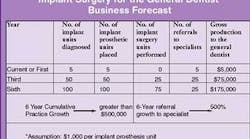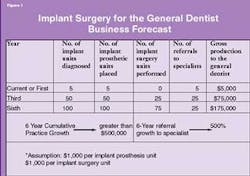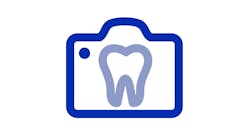Charles A. Vogel, DDS
Your practice can potentially produce a half million dollars in additional gross revenue over the next six years without taking away from current production. Simply put, by combining two already polished skills - surgery and endodontic - you can become a general dentist who performs a large number of his or her own implant surgeries.
Implant dentistry is where aesthetic dentistry was approximately 10 years ago. Dr. Scott Keith, a leading San Francisco dentist, explains it this way: "Implant dentistry is 'additive dentistry.' Other methods of replacing teeth are 'subtractive dentistry.' Additive dentistry is becoming more important in treatment-planning for those people who are going to live 30, 40, and 50 more years." The longer we study post-implant patients, the more striking the evidence that supports improvements in quality of oral health and life issues.
Why do dental implant surgery?
A paradigm shift in treatment-planning will occur the day you begin doing implant surgery. Some dental procedures that have been amassed in our dental armamentarium did not provide us with financial or self-fulfillment rewards. It was not until we believed and saw the successful fruits of our efforts that new concepts and ideas became part of our diagnosis and treatment plan. Changing the way we feel, think, and believe about dental implants will effect every complex treatment plan that we manage in the future.
Once treatment-plan case acceptance starts going up, so does the referral base. These satisfied customers who are enjoying highly successful, solid dental implants are going to refer their friends and family for these services which will reflect back on you in a multitude of ways. Not only will you be recognized as the cutting-edge implant dentist, but also as a friend who helps those with oral-health problems that have not been treated satisfactorily before. As your practice mix broadens, there is less dependency on any one particular kind of dentistry to generate income - and to negatively impact your income! The result is gross income rises as shown in Figure 1.
Practice plateaus occur when things become somewhat repetitious and mundane. Dental implant surgery can rejuvenate your interest in dentistry. Excitement and enthusiasm can be created between you and your team as you take on new challenges and have better solutions for your patients. This new-found synergy alone will more than pay the expenses that are incurred as a result of incorporating implant surgery into your practice.
Should you decide not to do implant surgery, your expanded knowledge, diagnostic capabilities, and abilities to enhance the prosthetic segment of your implant practice also can reap monetary rewards.
Patients look to us for help in making life-changing, long-term important decisions about their oral health. Education is the key for us and, ultimately, for them. As professionals, it is our obligation to advise them of all available possibilities, the consequences of doing nothing, the advantages and disadvantages to the solutions, and then charge them a fair and reasonable fee for achieving these goals. Without full understanding of implant dentistry, which involves the surgical placement of implants, we cannot fully guide our patients.
The best reason for doing dental implant surgery is this: because of our increased skill, knowledge, and judgement, we are better able to serve our clients.
Economic effects of implant surgery
Forecasting economic success too often is muddied by all of the "what ifs." In this case, the only "what ifs" are your level of desire to provide quality implant surgery, your enthusiasm to proceed with it, and establishing your fees.
In the hypothetical financial forecast in Figure 1, let's assume that the average fee in your office for a prosthetic implant fixture is $1,000 per unit and the surgical fee is $1,000 per implant. Let's also assume that you are currently providing five implant-prosthetic components per year, with the implant surgeries being performed by a specialist. If, over the next three years, your implant case acceptance is increased, and you do 50 implants a year and 50 percent of the surgeries, you now have a gross income from prosthetics and implants of $75,000!
The specialist you work with is happy about the 50-implant cases you diagnosed because you referred 25 complex cases to him. Progressing forward into the sixth year, you are diagnosing and presenting 100 implant cases per year. Because of your increased skills, you are doing 75 percent of the surgeries yourself and referring 25 percent of them out to the specialist. Your implant-center income at the end of the sixth year has gone from $5,000 to $175,000 per year and the referral numbers to the specialist have increased by 500 percent, making this a shared win-win financial reward. The specialist's fee revenues will reflect the more complex procedures he is doing for your patients, such as sinus lift and bone augmentations. As your case numbers and referrals increase, the specialist will be willing to provide you with technical assistance along the way, increasing your ability to do the simpler cases in your office.
The bottom line - during this six-year period your practice has generated an additional $500,000 in gross revenue!
The best practice to do implant surgery
You are the right person to do dental implant surgery if 30 to 40 percent of your current revenue is based on restorative dentistry. Performing simple surgeries, such as minor, impacted third molars and other noncomplicated procedures, should feel comfortable to you. Most importantly, doing a large percentage of your own endodontics will help you progress naturally into dental-implant surgery.
Now, let's talk about a hypothetical dental procedure. First, the patient is anesthetized. Secondly, after studying preoperative radiographs, a series of small rotary drills are used to incrementally and specifically enlarge the diameter and depth of the area. Next, after completely cleaning and debriding the area, the hole is carefully filled with a substance to create a biological seal. Now the question is, have we just discussed the endodontic treatment of a tooth, or have we discussed the placement of a dental implant? Depending upon the size of the rotary drills and the mental picture that you had in your mind of this scenario, it could have been either one. The leap from precisely performing successful endodontics to performing at least 50 percent of your own dental-implant surgeries is lessened when you are comfortable with using rotary instruments.
Practice mix in the next six years
If you will begin right now to conscientiously add to your continuing dental education and perform the simplest of dental-implant procedures, I predict that within a six-year period. your practice mix will be approximately 40 percent restorative dentistry, 10 percent endo (which may decrease as your confidence and implant surgical skills go up), and 10 percent dental-implant surgery. This will place your practice in a far more profitable position ... and less subject to the ups and downs of the latest trends in dentistry. The broader your service mix, the greater your ability to resist certain trend changes.
Steps to take to begin doing implant surgeries
Begin with the end in mind. Focus on the goals that seem reasonable for you. In your geographical market, grossing that added one-half-million dollars over the next six years might be reaching for the stars or less than realistic. So, draw your own Figure 1. Enter your own case numbers and financial goals a year at a time. Once your six-year plan is committed to paper, write down some small steps and a time table that you will utilize to get started on your path. Your steps might include:
- Assess your current endodontic and surgical skills.
- Explore various anesthetic options available within your community. (The only anesthetic I offer is local in conjunction with nitrous and/or oral sedatives.)
- Set up a lunch meeting with your current implant specialist. Many specialists see dental implants in the same light as we see occlusal fillings. They get far more excited about doing complex cases challenges and advancing their own skills. Involve the specialist in mapping out his/her own financial plan based on your referrals. The specialist more than likely already provides a variety of implant choices, based on the needs of the multiple dentists that he serves. From his store of knowledge, choose a single implant system that will be congruent with his services and serve the needs of the majority of your patients. An added benefit to using similar technology is that the dental-implant company you select will be more likely to allocate more resources to you because it already has an established presence in the community. The company's representative can play a major role in hands-on advice and materials procurement. (Personally, I have found the representative from Straumann ITI Dental Implant System to be very helpful.)
- Look for implant possibilities with your current patient base. A logical sequence might be to start with mini-implants. (Imitek's Mini-Implant overdenture has proved to be an inexpensive and less invasive solution for many denture-wearers.)
- Seed your extraction patients for dental implants.
- Remove teeth in such a way that it allows you to preserve the buccal lingual width of the bone. (Posterior single-tooth implants where more than adequate bone is present, are good possibilities for some of your early implants.)
- Attend a one-to-three-day implant course, devoted primarily to surgery.
- Preschedule implant-surgery cases to perform within a short period after you return from the seminar. This makes the surgical experience much less taxing on you because everything is still fresh in your mind.
- Take diagnostic models and radiographs to the symposium and get the lecturer's input about the feasibility of your treatment plan.
- Purchase the necessary equipment that you will need while at the course so that you are ready to complete the particular cases you have in mind.
- Deliver five surgical implants within the next 10 to 12 months.
- Reassess your commitment as a general dentist to continue to grow your in-house dental-implant cases.
- Meet again with your specialist at the end of the first year, and reassess your financial plans.
If you want this to happen, it will. Involve other people in your goals for doing implant surgeries. Allow them to share in your enthusiasm and listen to their ideas and accept their willingness to help. This is a journey that is going to change your practice and help you to raise the bar of providing optimal oral-health care to your patients.







